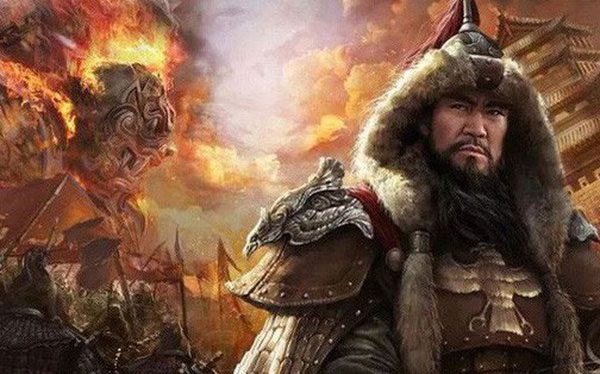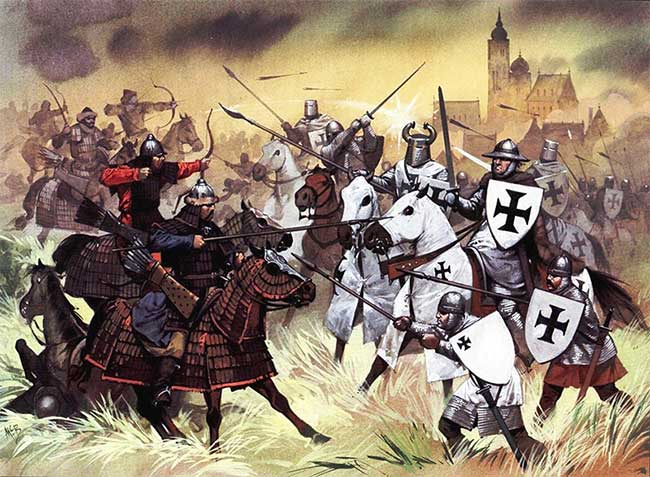The Mongol Empire was once the largest empire in the world, yet the Mongols were never able to fully conquer Europe, despite initial campaigns that seemed to guarantee their victory.
In the 13th century, the powerful Mongol army intended to invade all of Europe, instilling fear across the continent due to the Mongols’ overwhelming potential.

Genghis Khan died before he could launch a campaign to conquer Europe.
The Rise of Genghis Khan
Genghis Khan, born as Temüjin, faced a very difficult childhood. His father was poisoned by a rival tribe, leading Temüjin’s family to lose all power and live a challenging nomadic life.
In 1182, Temüjin was captured by members of his former tribe during a raid and was imprisoned with a yoke around his neck. He was fortunate to escape with the help of a jailer. During this time, his mother taught him many survival skills, from enduring harsh weather conditions in Mongolia to the importance of alliances with others. This led Temüjin to always contemplate uniting the Mongol tribes.
In his efforts to unite different factions, Temüjin broke traditional Mongolian customs. Instead of killing enemies or enslaving them, he committed to protecting them and persuading them to join future conquests. He also preferred to promote talented individuals who showed loyalty and acumen over favoring members of noble families.
These innovative ideas during that period helped Genghis Khan’s coalition grow stronger. As a result, by 1206, Genghis Khan had fully unified the Mongol tribes, laying the foundation for the largest empire in world history.

Differing climates and infectious diseases hindered the Mongol army.
By 1220, the Mongol Empire stretched from the Korean Peninsula to the Yangtze River in southern China, and to the Himalayas and Euphrates River (present-day Syria) in the west. The Mongols had mastered the technique of rapid attacks, a strategy later adopted by Nazi Germany. Stubborn enemies were besieged until exhaustion.
Genghis Khan divided his forces into two groups. The main army, led by Genghis Khan himself, traversed Afghanistan and northern India to return to the Mongolian steppes. Another contingent of about 30,000 was commanded by Jebe and Kublai, marching through the Caucasus and into Russia, launching deep attacks into Armenia and Azerbaijan.
During this time, Genghis Khan dispatched a small force to scout Poland and Hungary, aiming to advance westward into Europe. This contingent soon withdrew back to Mongolia in 1223.
The reasons behind the cancellation of the decision to invade Europe remain unclear. Historians suggest that while the Mongol army was seemingly invincible against other forces, it was rendered powerless when confronted by a force of malaria-carrying mosquitoes, particularly among the troops stationed in the Caucasus and along the Black Sea.
At that time, Genghis Khan himself was suffering from chronic malaria. Most historians agree that Genghis Khan died in 1227 at the age of 65 due to various ailments stemming from a weakened immune system after contracting malaria.
The burial site of Genghis Khan remains a mystery to this day. The Mongols at the time did not take the threat posed by malaria seriously, despite the empire still being very powerful when Genghis Khan passed away.
The Campaign to Conquer Europe and Its Failures
After Genghis Khan’s death, his son Ögedei assumed power and launched a campaign to invade Europe from 1236 to 1242. The Mongol army chose the route through eastern Russia, capturing the Baltic states before advancing to Budapest, Hungary, and the Danube River in December 1241. From Budapest, the Mongols moved deeper into Austria and then southward, but ultimately turned east into the Balkans in 1242.

The Mongol army once reached the Danube River but then withdrew.
The Mongol army retreated when Ögedei suddenly died, and no commander was in the right mindset to advance further west.
Former British Prime Minister Winston Churchill wrote: “There was a time when it seemed that all of Europe would fall into the hands of the Mongols from the east. The Mongol cavalry, skilled in archery, swept through Russia, Poland, and Hungary in 1241. They defeated the Germans and European cavalry near Buda but then abruptly withdrew, and Western Europe was fortunate to escape disaster.”
The Mongols’ weakness was their inability to adapt to humid climatic conditions, plagued by mosquitoes. Heavy rains turned the Magyar plains in Eastern Europe into a swamp, resembling a paradise for malaria-carrying mosquitoes. It was these mosquitoes that helped prevent the Mongols from overrunning the West, effectively “sucking dry” their dreams of conquering Europe.
Although the Mongols had some limited successes during their invasion of Europe, they were repeatedly forced to retreat when faced with malaria, other diseases, and the strong defenses of allied European nations. The Mongols did not prioritize scientific research and technology, relying solely on nature, which could not stop the proliferation of mosquitoes.
Historian John Keegan, who studied the Mongols for many years, stated: “The Mongols failed to project military power from sub-tropical and desert regions into the rain-soaked areas of Europe, and they had to accept defeat.”
By the time the Mongol Empire began to decline in 1368, mosquitoes and malaria parasites were still cited as one of the primary reasons for this decline, alongside internal strife and civil wars within the Mongol tribes.


















































